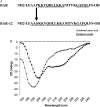Structural dissection and in vivo effectiveness of a peptide inhibitor of Porphyromonas gingivalis adherence to Streptococcus gordonii
- PMID: 21041492
- PMCID: PMC3019905
- DOI: 10.1128/IAI.00361-10
Structural dissection and in vivo effectiveness of a peptide inhibitor of Porphyromonas gingivalis adherence to Streptococcus gordonii
Abstract
The interaction of the minor fimbrial antigen (Mfa) with streptococcal antigen I/II (e.g., SspB) facilitates colonization of the dental biofilm by Porphyromonas gingivalis. We previously showed that a 27-mer peptide derived from SspB (designated BAR) resembles the nuclear receptor (NR) box protein-protein interacting domain and potently inhibits this interaction in vitro. Here, we show that the EXXP motif upstream of the NR core α-helix contributes to the Mfa-SspB interaction and that BAR reduces P. gingivalis colonization and alveolar bone loss in vivo in a murine model of periodontitis. Substitution of Gln for Pro(1171) or Glu(1168) increased the α-helicity of BAR and reduced its inhibitory activity in vitro by 10-fold and 2-fold, respectively. To determine if BAR prevents P. gingivalis infection in vivo, mice were first infected with Streptococcus gordonii and then challenged with P. gingivalis in the absence and presence of BAR. Animals that were infected with either 10(9) CFU of S. gordonii DL-1 or 10(7) CFU of P. gingivalis 33277 did not show a statistically significant increase in alveolar bone resorption over sham-infected controls. However, infection with 10(9) CFU of S. gordonii followed by 10(7) CFU of P. gingivalis induced significantly greater bone loss (P < 0.01) than sham infection or infection of mice with either organism alone. S. gordonii-infected mice that were subsequently challenged with 10(7) CFU of P. gingivalis in the presence of BAR exhibited levels of bone resorption similar to those of sham-infected animals. Together, these results indicate that both EXXP and the NR box are important for the Mfa-SspB interaction and that BAR peptide represents a potential therapeutic that may limit colonization of the oral cavity by P. gingivalis.
Figures





Similar articles
-
Functional assessment of peptide-modified PLGA nanoparticles against oral biofilms in a murine model of periodontitis.J Control Release. 2019 Mar 10;297:3-13. doi: 10.1016/j.jconrel.2019.01.036. Epub 2019 Jan 25. J Control Release. 2019. PMID: 30690103 Free PMC article.
-
BAR-encapsulated nanoparticles for the inhibition and disruption of Porphyromonas gingivalis-Streptococcus gordonii biofilms.J Nanobiotechnology. 2018 Sep 15;16(1):69. doi: 10.1186/s12951-018-0396-4. J Nanobiotechnology. 2018. PMID: 30219060 Free PMC article.
-
Structural characterization of peptide-mediated inhibition of Porphyromonas gingivalis biofilm formation.Infect Immun. 2006 Oct;74(10):5756-62. doi: 10.1128/IAI.00813-06. Infect Immun. 2006. PMID: 16988253 Free PMC article.
-
Invasion strategies of the oral pathogen porphyromonas gingivalis: implications for cardiovascular disease.Invasion Metastasis. 1998-1999;18(2):57-69. doi: 10.1159/000024499. Invasion Metastasis. 1998. PMID: 10364686 Review.
-
Molecular interaction of Porphyromonas gingivalis with host cells: implication for the microbial pathogenesis of periodontal disease.J Periodontol. 2003 Jan;74(1):90-6. doi: 10.1902/jop.2003.74.1.90. J Periodontol. 2003. PMID: 12593602 Review.
Cited by
-
Quantitative proteomics reveal distinct protein regulations caused by Aggregatibacter actinomycetemcomitans within subgingival biofilms.PLoS One. 2015 Mar 10;10(3):e0119222. doi: 10.1371/journal.pone.0119222. eCollection 2015. PLoS One. 2015. PMID: 25756960 Free PMC article.
-
Nanoparticles in Periodontitis Therapy: A Review of the Current Situation.Int J Nanomedicine. 2024 Jul 9;19:6857-6893. doi: 10.2147/IJN.S465089. eCollection 2024. Int J Nanomedicine. 2024. PMID: 39005956 Free PMC article. Review.
-
The enduring importance of animal models in understanding periodontal disease.Virulence. 2015;6(3):229-35. doi: 10.4161/21505594.2014.990806. Virulence. 2015. PMID: 25574929 Free PMC article. Review.
-
The oral microbiota: dynamic communities and host interactions.Nat Rev Microbiol. 2018 Dec;16(12):745-759. doi: 10.1038/s41579-018-0089-x. Nat Rev Microbiol. 2018. PMID: 30301974 Free PMC article. Review.
-
Rapid Release Polymeric Fibers for Inhibition of Porphyromonas gingivalis Adherence to Streptococcus gordonii.Front Chem. 2020 Jan 21;7:926. doi: 10.3389/fchem.2019.00926. eCollection 2019. Front Chem. 2020. PMID: 32039149 Free PMC article.
References
-
- Andersen, J. P., B. Vilsen, E. Leberer, and D. H. MacLennan. 1989. Functional consequences of mutations in the beta-strand sector of the Ca2+-ATPase of sarcoplasmic reticulum. J. Biol. Chem. 264:21018-21023. - PubMed
-
- Andrade, M. A., P. Chacon, J. J. Merelo, and F. Moran. 1993. Evaluation of secondary structure of proteins from UV circular dichroism spectra using an unsupervised learning neural network. Protein Eng. 6:383-390. - PubMed
-
- Baker, P. J., L. Howe, J. Garneau, and D. C. Roopenian. 2002. T cell knockout mice have diminished alveolar bone loss after oral infection with Porphyromonas gingivalis. FEMS Immunol. Med. Microbiol. 34:45-50. - PubMed
Publication types
MeSH terms
Substances
Grants and funding
LinkOut - more resources
Full Text Sources
Other Literature Sources
Miscellaneous

